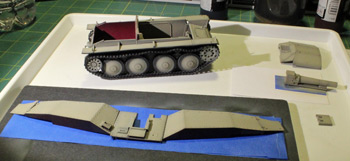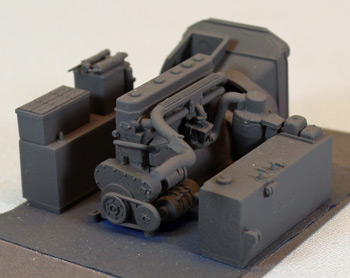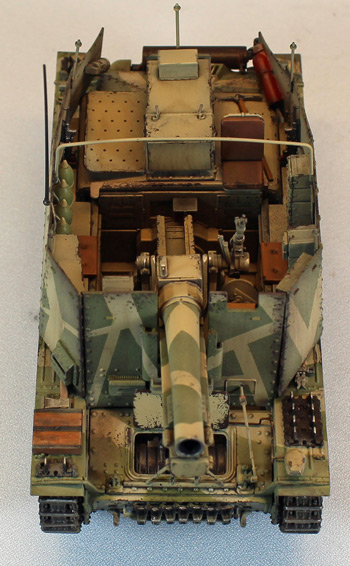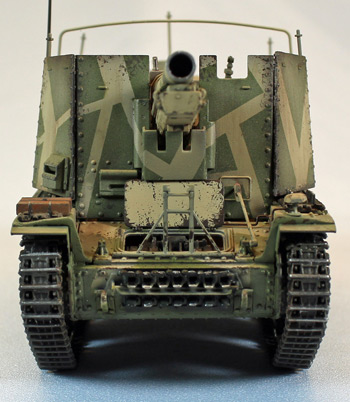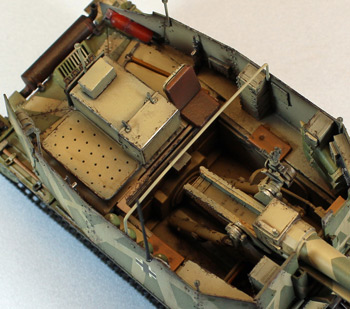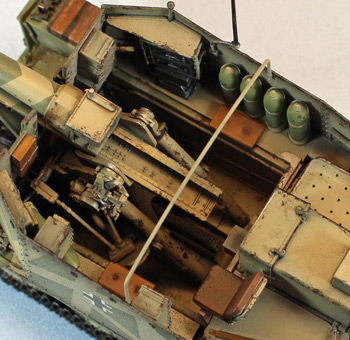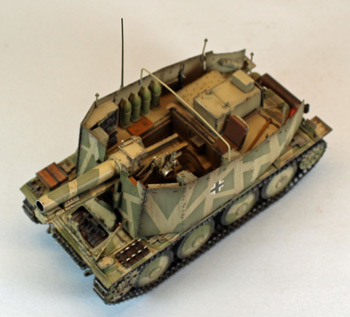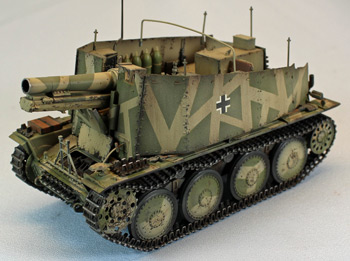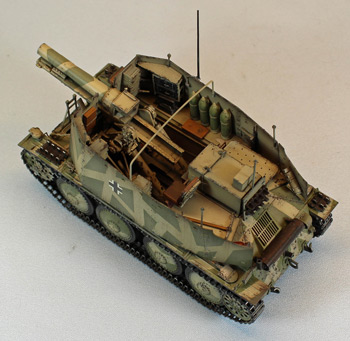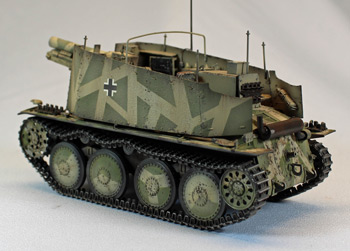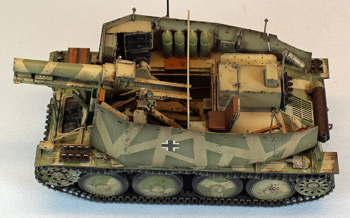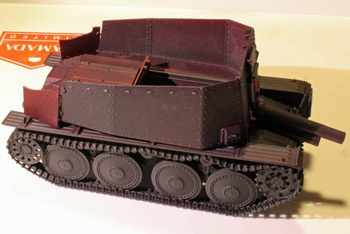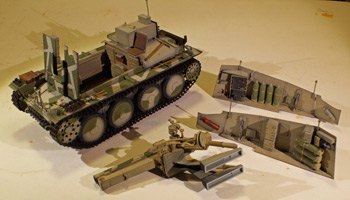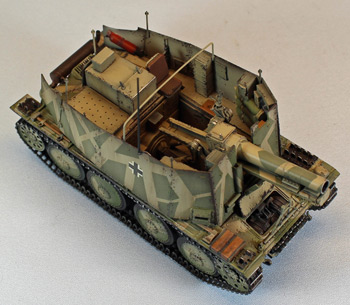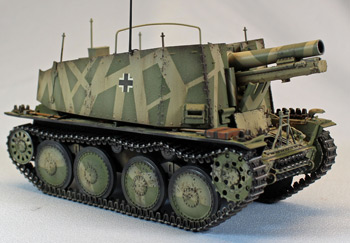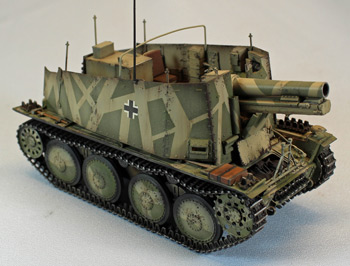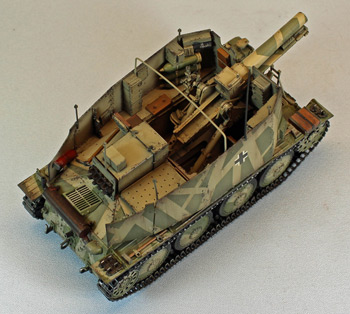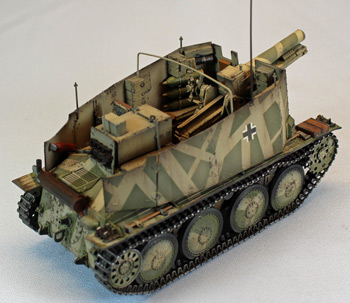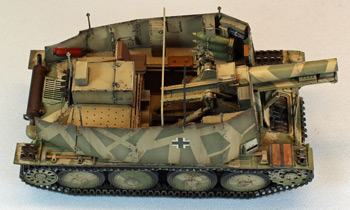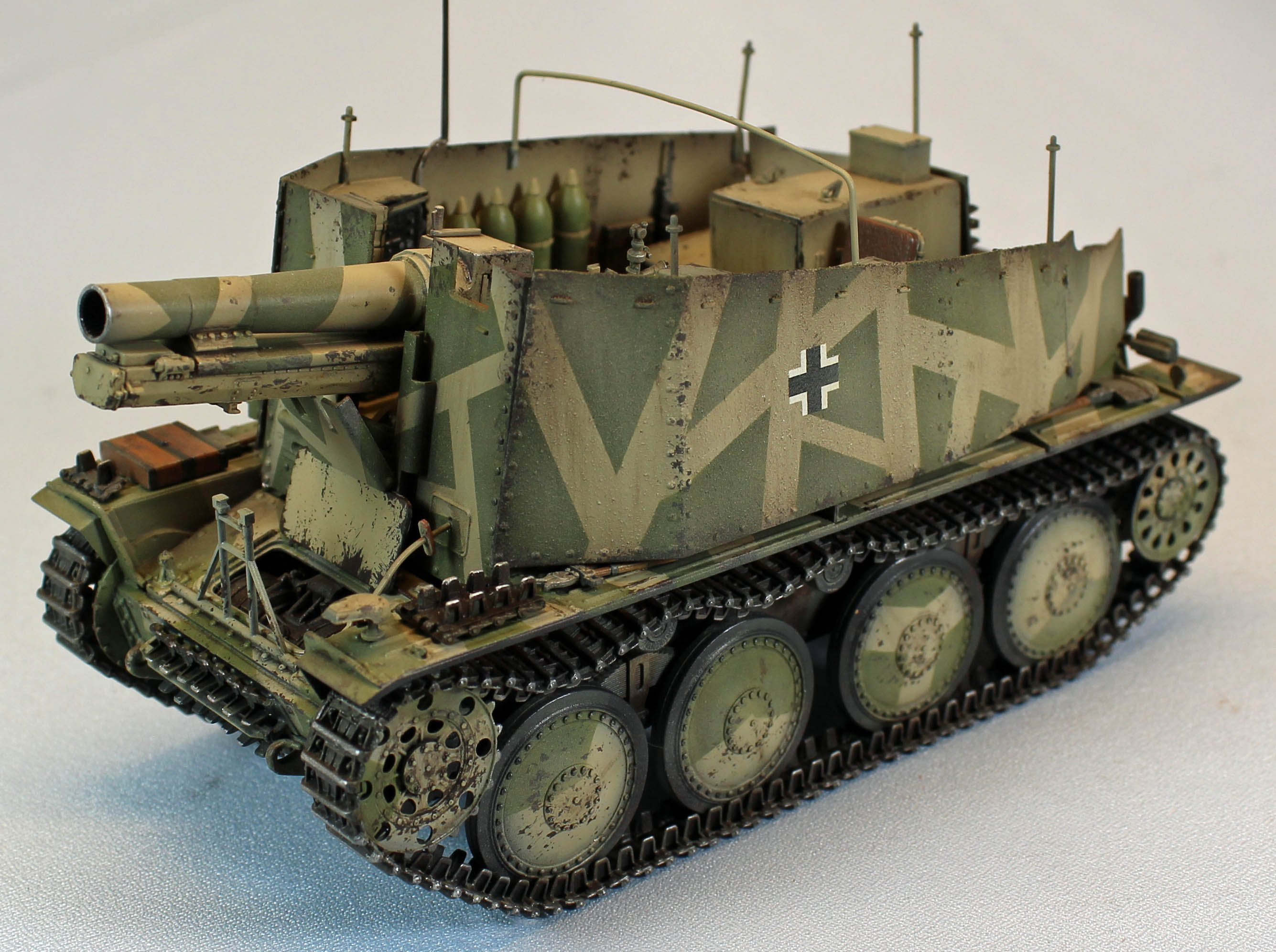
Reviews
Armor
Dragon Sd.Kfz. 1381 Geschutzwagen 38 H fur s. JG.331
by Eric Christianson
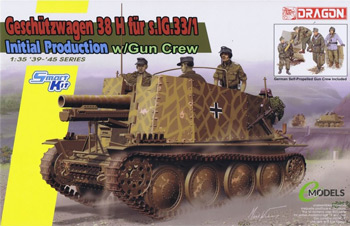 Model: Sd.Kfz. 1381 Geschutzwagen 38 H fur s. JG.331
Model: Sd.Kfz. 1381 Geschutzwagen 38 H fur s. JG.331
Reviewed by: Eric Christianson, IPMS # 42218
Scale: 1/35
Company: Dragon
Price: $59.99
Product/Stock #: 06857
Website: Dragon
Product Web Page: View
Product provided by: Dragon
Dragon has recently re-released the diminutive Geschutzwagen 38 H sporting the relatively large sIG 33 field howitzer – a kit that has been improved upon over the twenty-plus years it’s been out. As expected, the molding, fit and engineering found in today’s kit is up to Dragon’s excellent standards. A tremendous amount of detail adorns the open-topped chassis, including a nice engine and transmission, along with MagicTrack and an aluminum barrel. A very impressive offering that builds into a model about the size of my fist!
The Grille ("cricket") was a series of self-propelled artillery vehicles used by Nazi Germany during World War II. The Grille series was based on the Czech Panzer 38(t) tank chassis and used a 15cm sIG 33 infantry gun. The first variant of the Grille (and the subject of this review) was based on the Panzer 38(t) Ausf. H chassis, which had its engine in the rear. Instead of a turret, the vehicle had a low-slung superstructure and open fighting compartment. The 15cm Schweres InfanterieGeschütz (sIG) 33 (heavy infantry gun) was mounted in the front of this armored compartment. Being built on a tank chassis, its hull armor was 50 mm (front) and its superstructure armor was 25 mm (front). A total of 200 were produced in the BMM factory in Prague from February to November 1943. The official designation was 15 cm Schweres Infanteriegeschütz 33 (Sf) auf Panzerkampfwagen 38(t) Ausf. H (Sd.Kfz. 138/1).
Opening the box
Combining the s.IG.33 field howitzer and the PzKpfw 38(t) chassis is a no-brainer for Dragon – the company has produced excellent kits of both, and they each have been used in a variety of Dragon kits. This release simply uses sprues already in inventory, with a few new bits added in. As a consequence, the diminutive vehicle still comes in a box stuffed with sprues, and a lot of what you get is not used. Fortunately, there are plenty of quality parts headed for your spares box; gun barrels, machine guns, radio sets, ammunition rounds, etc., etc. In my copy, Dragon even included their German Self-Propelled Gun Crew figure set of four SPH crewmen in various poses.
The contents of the box include:
- 18 sprues in soft, light grey plastic, packaged in separate bags
- German Self-Propelled Gun Crew (4 Figures Set (6530) - may not be present in all kits)
- 1 lower hull packaged separately
- 1 baggie of MagicTrack individual track links in light grey plastic
- 1 sprue of clear parts
- 2 photo-etch sheets, including mesh for the rear muffler
- 1 aluminum sIG 33 barrel with machined interior rifling
- 1 pre-bent wire to serve as an electric line to the front headlight
- 1 8-page blue and white instruction sheet with 19 steps
The kit comes with two finishing schemes represented using blue-and-white ink three-view drawings and a small (but perfectly registered) sheet of three Balkenkreuz decals from Cartograph of Italy. These schemes include:
- Unidentified Unit, Eastern Front 1943 (Green ‘giraffe’ camouflage pattern over German Yellow)
- Test Run, B.M.M. Factory 1943 (Overall late war German yellow)
The Instructions
This is a ‘fortified re-box’, containing sprues from several different Dragon kits, which sometimes leads to inaccuracies in the instructions. Thankfully, Dragon uses a color coded system (blue and black) on the parts map and instructions to distinguish between sprues that have the same letters. The issues encountered have been noted below
Things to consider before building
This is an open-topped vehicle, meaning that the ‘build it all and then paint it’ approach isn’t the best course to take. The busy interior includes a rudimentary transmission, part of which is clearly visible around and in front of the gun. The engine can be exposed by modeling various hatches in their open configuration.
The fenders will create a very tight fit around the front drive sprockets, so adding the track before the fenders is recommended.
The main gun and its substructure can be dropped in at the very end, after painting and weathering, assuming you’ve left room on the floor of the interior for it.
In typical Dragon style, there are a number of build options available to the modeler, so some up-front decision making is in order.
I chose to incorporate a rather intricate camouflage design which requires a few departures from the instructions so that painting could be done while I still had access to certain parts. Accordingly, I stopped assembly in Step 11 (after engine installation) to build the main gun, and to attach specific parts to the inner and outer walls of the superstructure that would incorporate the external camouflage pattern. Once that was done, I resumed assembly with Step 12.
The Build
Due to the simple design of the 38t chassis, the low parts count here is a breeze compared to some of the other German AFV’s. That said, Dragon chose a slightly fiddley approach to the assembly of each of the four bogeys. Each bogey can articulate into a different position before gluing, presumably to allow for staging the model on an uneven surface. For those of us who simply place our models on a flat surface, this approach doesn’t guarantee that all wheels will touch the ground evenly when set. Consequently, I prepared all the parts for Steps 1-6 beforehand, so I could quickly move through these steps and set the completed chassis on a smooth surface to let everything dry true.
Dragon provides a nice representation of an engine and transmission for the model, although both are partly covered up on the final model. The rear deck that fits over the engine compartment is molded as three pieces, a center section that will be covered by a large ammunition locker (in Step 19), and two large hatches that only open to about 45 degrees on each side (Step 9).
The image in Step 9 shows cavities on each side of the inner hull where the transmission axles slip in. These cavities are actually filled in by this time, way back in Step 1 with the assemblies labeled ‘D’. No worries, everything still fits. Be aware that Part B43 in the instructions is actually Part B44 on the sprue.
Dragon provides a nice three-station rack for storing spare 150mm ammunition on the interior of the upper hull. Unfortunately, there are no clues provided for where exactly to place the two multi-tier racks, or how to insure that the racks are parallel to each other. I ended up squaring the racks on a thin piece of card stock and then gluing the card with the two racks into the side of the upper hull. The card stock disappeared after painting.
Dragon includes parts for 20 fuse storage boxes, although only 10 are used, which is nice in case you want to use more to fill up the (very little!) unused space.
Dragon offers no less than six different options on the rear hull of the vehicle in Step 3. I chose to attach the brackets that hold the exhaust muffler to the muffler rather than to the hull as instructed, and attached the muffler assembly later in the build so I could paint and weather it separately.
When attaching the pioneer tools and other on-deck equipment to the fenders in Steps 13 and 14 make sure they will not interfere with sides of the superstructure added later. I had to remove several items (jack, crowbar, pick axe) even though I followed the instructions. Some of the tools will be almost completely covered up so working some of the PE hasps might be a fool’s errand.
In Step 14, the flat panel (Part 49) that sits horizontally over the downward-angled starboard-side engine hatch has no visible means of support. I had to add a post underneath it to bring it up where it needs to be.
Note that Part RA48 in the instructions is actually Part RA8 on the sprue, and in Step 19, Parts F67 and F9 in the instructions are actually Parts F75 and F10, respectively, on the sprue. In Step 20, the lower portion of the gun support (Part F19) is about 1/16th of an inch too short to fit between the two support posts (F8/F9). Checking my work verified this fit problem, unusual for Dragon. Since this support sits right up front and center, I decided had no choice but to scratch build one or simply stick what I had on the hull. Unfortunately, time limitations drove me to the latter.
Also, the fit and placement of the hardware (F81/82 and F13/F14/F15) that raises and lowers the gun support is vague at best. I could not find any suitable photos of this area so I put things where I thought they could go, fit be damned.
In Step 21, Parts F22 and F24 in the instructions are actually Parts F37 and F52, respectively, on the sprue.
Besides these minor issues, the overall fit of the (huge) amount of detail adorning the main hull of this diminutive vehicle was excellent.
Dragon included an aluminum barrel in the kit, a throwback to before slide molding became de rigueur in their kits. Fortunately this barrel fits snug into its receptacle, removing my main complaint with metal barrels.
Steps 22 through 24 address the main weapon and everything went together surprisingly well. You’ll have to use a little patience as the hardware that cradles the main gun is a little fiddly and should be assembled slowly, allowing the glue to dry before continuing in some places. Studying some of the other images will help with angles and parts placement.
Dragon has included MagicTrack with the Geschutzwagen; a good choice. The runs are not sided, and the links are beautifully rendered. As always, however, there are tiny mold release marks, two per link, and these could be removed by sanding if one cares to (I don’t). Dragon provides 240 links total, and specifies 96 per run, leaving the remainder as spares and for the run across the front of the vehicle and elsewhere. I actually used only 95 links per side, and that’s after allowing for a significant ‘sag’ in the track – the main benefit of using Magic track.
Painting and Finish
I decided to paint the sIG Geschutzwagen using a slightly complex camouflage pattern which required me to deviate from the instructions in several places so that I could mask the parts more easily. I also wanted to employ paint-chipping throughout using the hairspray technique. While there are several approaches and paint products that work for doing this, I have found that Tamiya paints, thinned with Gunze Leveling Thinner, works best for me, so that is what I used.
Even though I worked in stages, everything started with a primer coat consisting of Krylon Color Master with Durable ColorMax Technology rattlecan (Flat Black) lacquer paint. This is a superior product, drying super thin and very tough (not to mention cheap and quick). Once the lacquer paint degassed overnight, I touched things up back in the paint booth using Tamiya NATO Black, including the tire portions of the wheels.
I then dusted everything except the wheels with Vallejo German Red-Brown Surface Primer – this is the color I want to expose when the camouflage layer is chipped away. I left the lower chassis and wheels black.
The primer/pre-shade coat gives the plastic some grip for the following coats, and fills in the recesses, creating a shadow effect near the flat surface edges. This will add depth for the subsequent coats to come.
Once the paint had dried, I followed up with a layer of rattlecan hairspray on everything – at this point I don’t know where I will add the chipping, but the acrylic layer is very thin and doesn’t affect subsequent layers of paint, whether it is chipped off or not.
Also, the hairspray will act as a mask for the tire portions of the wheels when those are painted. I use TRESemmé ‘Two Extra Hold’ hairspray directly out of the aerosol can, but I don’t think it really matters what type you use or how you apply it, as long as you get a decent amount on the model.
From Step 12 onwards I painted parts added with the same color mixes used on the exterior where appropriate. For parts (such as the fuse storage boxes) I added hairspray so they could be ‘chipped’ later. Once everything was in place, I rubbed off some of the paint to simulate chipping, and gave the entire interior several filter layers of Mig Wash Brown Oils and a pin wash of Mig Dark Wash, both thinned with Mona Lisa.
I used a variety of Vallejo paints for the interior detail including Panzer Aces (PA) 312 for the seats, and PA 336 and 340 for the racked ammunition rounds.
Once I was satisfied, I weathered the engine and interior using LifeColor 207 ‘Oil’, Vallejo 73.815 ‘Engine Grime’ and Vallejo 73.818 ‘Engine Soot’ acrylics.
The two hanging Schmeisser MP 40’s were first painted Flat Black, then covered with AK Interactive True Metal ‘Gun Metal’ before being buffed out to bring out the detail.
I then hand-painted the jack block using Vallejo New Wood, leaving the strapping black.
The busy camouflage pattern I chose only adorned the exterior surfaces of the vehicle, and the front 2/3rds of the gun barrel. Since I needed to add a variety of detail to the interior and exterior of the model, I decided to paint the exterior camouflage first, stopping after attaching the fenders in Step 11.
Once the primer, pre-shade and hairspray had dried, I laid down a light coat of Tamiya XF-55 Deck Tan with a few drops of XF-59 Desert Yellow added to give it a yellow tint. Once that was dry, I used different widths of Tamiya tape to create a cross-hatch pattern on the exterior surfaces, which were still in pieces, taped to sticky board. Over that I added a layer of Tamiya XF-58 Olive Green, lightened a bit with Deck Tan. I mixed extra batches of both camouflage colors for the remaining detail that had yet to be added. Pulling the tape off I examined my work and touched up any spots that needed it. Before the paint had dried too long, I went to work with a stiff brush moistened with water, rubbing off the paint along various edges to give everything a chipped-paint look to it. Once satisfied, I returned to Step 12 and carried on with assembly. Once that was done, I hand-brushed AK Interactive Track Wash on to the track being careful to miss the wheels themselves.
With the model in four major pieces now (main hull, 2 sides, and gun) I was ready for weathering.
With painting and initial filters completed, I hand-brushed Future (acrylic) on the two areas that would receive the decals to give them a smooth surface to set up on. While the decals were drying I hand painted the array of deck detail and pioneer tools using mixes of Vallejo New Wood and Flat Flesh paints for the wooden detail, and AK True Metal (Gun Metal) ‘wax paint’ for the metallic portions.
Once dry, I sprayed a heavy coat of Future on everything to seal the decals and set the model up for weathering.
Now that I had a glossy surface, I started weathering with an overall pin-wash using a 10:1 ratio of Mona Lisa thinner to Mig Dark Brown (enamel) Wash. I find this mixture perfect when applied to a glossy surface – the detail pops and the wash leaves no smudges.
After applying wash to wheels, I placed the vehicle on its side so that the wash would not run down vertically due to gravity, but puddle up and dry, simulating real grease and grime.
I brushed Mig Wash Brown and Old Holland Warm Sepia Oil paints directly from the tubes on various wooden parts, leaving them to set overnight. In the morning I wiped the oil paint off using Q-tips, leaving behind a realistic wood finish. The glossy acrylic coat underneath prevents the parts from soaking in too much oil paint.
Once the oil-based products had a chance to dry, I airbrushed a thin line of Vallejo Model Color German Cam Black Brown (70822) along the edges of the super structure walls, and added a ‘road-dusting’ coat of Vallejo Model Air Light Brown along the track. Once finished, I laid down a coat of Vallejo Flat Varnish to kill any shiny spots still remaining. I cut all three of these products 50/50 with Vallejo Airbrush Thinner, and then added a few drops of Liquitex Flow Aid to improve flow.
The last touch was to go over some of the edges and weld seams with a Silver Artists Oil Paint (Gamblin) using my finger, as well as Uschi Chrome Metal Polishing Powder applied with a rubber-tipped artists blender.
Conclusion
Building this kit was a lot of fun. This was my fourth Dragon 38t-based model and repetition definitely helps in knowing what works and what doesn’t. The fit, as always, is spot on and really helps with the high parts count. I would have liked to have plastic pioneer tool alternatives (with molded on attachment hardware), but other than that, as I said, the project was a lot of fun. Dragon kits are amazing – the detail, the design and engineering, opening hatches, slide molding, Magic Track - Dragon produces some of the very finest models in the industry, and that’s what keeps me coming back for more.
I’ve developed a real fondness for (both) 38(t)-based armor, as well as the s.IG.33 field howitzer, and Dragon is my go-to company for these little gems since they produce such a large variety of both. This little open-topped howitzer will be a unique addition to my model case.
I would like to thank Dragon Models for providing this kit for review, and to IPMS USA for giving me the opportunity to review it.

